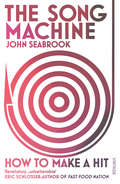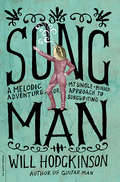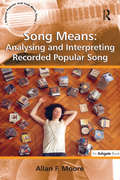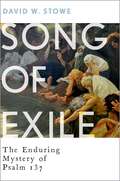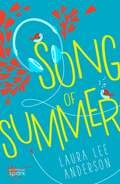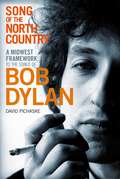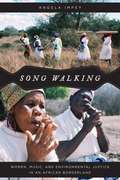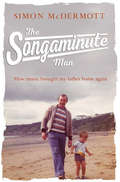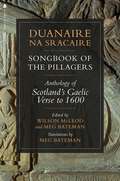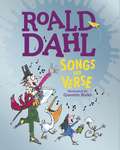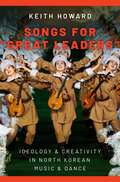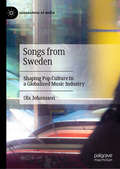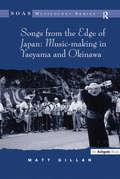- Table View
- List View
The Song Machine: How to Make a Hit
by John SeabrookHow do you make a song a global smash hit that is guaranteed to make $millions? Who are the hit-manufacturers that can create a tune that is so catchy, so wildly addictive, that it sticks in the minds of millions of listeners? And who are the powerful few that have the capacity to transform, say, a young Barbadian woman called Robyn Rihanna Fenty into the global megastar that is Rihanna? In The Song Machine, John Seabrook dissects the workings of this machine, travelling the world to reveal its hidden formulas, and interview its geniuses – ‘the hitmakers’ – at the centre of it all. Hilarious and jaw-droppingly shocking, this book will change how you think and feel about music, as well as how you listen to it.
Song Man: A Melodic Adventure, or, My Single-Minded Approach to Songwriting
by Will HodgkinsonSong man is the endearing sequel to Will Hodgkinson's Guitar Man, wherein our hero, having learned to play guitar (badly) in six months, endeavors to unlock the process of songwriting and ultimately record a single. Featuring pithy, humorous, and illuminating one-on-one songwriting lessons with Keith Richards of the Rolling Stones, Ray Davies of the Kinks, Andy Partridge of XTC, Arthur Lee of Love, Chan Marshall of Cat Power, Bob Stanley of Saint Etienne, Gruff Rhys of Super Furry Animals, and a host of others who run the gamut from unknown muses to cult icons to superstars-including Hodgkinson's lovable crew of ne'er-do-wells first introduced in Guitar Man-Song Man is at once an investigation into the most ephemeral of arts and a highly readable journey of discovery.
Song Means: Analysing and Interpreting Recorded Popular Song (Ashgate Popular and Folk Music Series)
by Allan F. MooreThe musicological study of popular music has developed, particularly over the past twenty years, into an established aspect of the discipline. The academic community is now well placed to discuss exactly what is going on in any example of popular music and the theoretical foundation for such analytical work has also been laid, although there is as yet no general agreement over all the details of popular music theory. However, this focus on the what of musical detail has left largely untouched the larger question - so what? What are the consequences of such theorization and analysis? Scholars from outside musicology have often argued that too close a focus on musicological detail has left untouched what they consider to be more urgent questions related to reception and meaning. Scholars from inside musicology have responded by importing into musicological discussion various aspects of cultural theory. It is in that tradition that this book lies, although its focus is slightly different. What is missing from the field, at present, is a coherent development of the what into the so what of music theory and analysis into questions of interpretation and hermeneutics. It is that fundamental gap that this book seeks to fill. Allan F. Moore presents a study of recorded popular song, from the recordings of the 1920s through to the present day. Analysis and interpretation are treated as separable but interdependent approaches to song. Analytical theory is revisited, covering conventional domains such as harmony, melody and rhythm, but does not privilege these at the expense of domains such as texture, the soundbox, vocal tone, and lyrics. These latter areas are highly significant in the experience of many listeners, but are frequently ignored or poorly treated in analytical work. Moore continues by developing a range of hermeneutic strategies largely drawn from outside the field (strategies originating, in the most part, within psychology and philosophy) but still deeply r
Song Means: Analysing and Interpreting Recorded Popular Song (Ashgate Popular and Folk Music Series)
by Allan F. MooreThe musicological study of popular music has developed, particularly over the past twenty years, into an established aspect of the discipline. The academic community is now well placed to discuss exactly what is going on in any example of popular music and the theoretical foundation for such analytical work has also been laid, although there is as yet no general agreement over all the details of popular music theory. However, this focus on the what of musical detail has left largely untouched the larger question - so what? What are the consequences of such theorization and analysis? Scholars from outside musicology have often argued that too close a focus on musicological detail has left untouched what they consider to be more urgent questions related to reception and meaning. Scholars from inside musicology have responded by importing into musicological discussion various aspects of cultural theory. It is in that tradition that this book lies, although its focus is slightly different. What is missing from the field, at present, is a coherent development of the what into the so what of music theory and analysis into questions of interpretation and hermeneutics. It is that fundamental gap that this book seeks to fill. Allan F. Moore presents a study of recorded popular song, from the recordings of the 1920s through to the present day. Analysis and interpretation are treated as separable but interdependent approaches to song. Analytical theory is revisited, covering conventional domains such as harmony, melody and rhythm, but does not privilege these at the expense of domains such as texture, the soundbox, vocal tone, and lyrics. These latter areas are highly significant in the experience of many listeners, but are frequently ignored or poorly treated in analytical work. Moore continues by developing a range of hermeneutic strategies largely drawn from outside the field (strategies originating, in the most part, within psychology and philosophy) but still deeply r
Song of Exile: The Enduring Mystery of Psalm 137
by David W. StoweOft-referenced and frequently set to music, Psalm 137 - which begins "By the rivers of Babylon, there we sat down, yea, we wept, when we remembered Zion" - has become something of a cultural touchstone for music and Christianity across the Atlantic world. It has been a top single more than once in the 20th century, from Don McLean's haunting Anglo-American folk cover to Boney M's West Indian disco mix. In Song of Exile, David Stowe uses a wide-ranging, interdisciplinary approach that combines personal interviews, historical overview, and textual analysis to demonstrate the psalm's enduring place in popular culture. The line that begins Psalm 137 - one of the most lyrical of the Hebrew Bible - has been used since its genesis to evoke the grief and protest of exiled, displaced, or marginalized communities. Despite the psalm's popularity, little has been written about its reception during the more than 2,500 years since the Babylonian exile. Stowe locates its use in the American Revolution and the Civil Rights movement, and internationally by anti-colonial Jamaican Rastafari and immigrants from Ireland, Korea, and Cuba. He studies musical references ranging from the Melodians' Rivers of Babylon to the score in Kazakh film Tulpan. Stowe concludes by exploring the presence and absence in modern culture of the often-ignored final words: "Happy shall he be, that taketh and dasheth thy little ones against the stones." Usually excised from liturgy and forgotten by scholars, Stowe finds these words echoed in modern occurrences of genocide and ethnic cleansing, and more generally in the culture of vengeance that has existed in North America from the earliest conflicts with Native Americans. Based on numerous interviews with musicians, theologians, and writers, Stowe reconstructs the rich and varied reception history of this widely used, yet mysterious, text.
Song of Exile: The Enduring Mystery of Psalm 137
by David W. StoweOft-referenced and frequently set to music, Psalm 137 - which begins "By the rivers of Babylon, there we sat down, yea, we wept, when we remembered Zion" - has become something of a cultural touchstone for music and Christianity across the Atlantic world. It has been a top single more than once in the 20th century, from Don McLean's haunting Anglo-American folk cover to Boney M's West Indian disco mix. In Song of Exile, David Stowe uses a wide-ranging, interdisciplinary approach that combines personal interviews, historical overview, and textual analysis to demonstrate the psalm's enduring place in popular culture. The line that begins Psalm 137 - one of the most lyrical of the Hebrew Bible - has been used since its genesis to evoke the grief and protest of exiled, displaced, or marginalized communities. Despite the psalm's popularity, little has been written about its reception during the more than 2,500 years since the Babylonian exile. Stowe locates its use in the American Revolution and the Civil Rights movement, and internationally by anti-colonial Jamaican Rastafari and immigrants from Ireland, Korea, and Cuba. He studies musical references ranging from the Melodians' Rivers of Babylon to the score in Kazakh film Tulpan. Stowe concludes by exploring the presence and absence in modern culture of the often-ignored final words: "Happy shall he be, that taketh and dasheth thy little ones against the stones." Usually excised from liturgy and forgotten by scholars, Stowe finds these words echoed in modern occurrences of genocide and ethnic cleansing, and more generally in the culture of vengeance that has existed in North America from the earliest conflicts with Native Americans. Based on numerous interviews with musicians, theologians, and writers, Stowe reconstructs the rich and varied reception history of this widely used, yet mysterious, text.
Song of Summer
by Laura Lee AndersonThe thirteen qualities of Robin's Perfect Man range from the mildly important "Handsome†? to the all-important "Great taste in music.†? After all, Westfield's best high school folk musician can't go out with some schmuck who only listens to top 40 crap. So when hot Carter Paulson walks in the door of Robin's diner, it looks like the list may have come to life after all...until she realizes he's profoundly deaf. Carter isn't looking for a girlfriend. Especially not a hearing one. Not that he has anything against hearing girls, they just don't speak the same language. But when the cute waitress at Grape Country Dairy makes an effort to talk with him, he takes her out on his yellow Ducati motorcycle.Music, language, and culture all take a backseat as love drives the bike. But how long can this summer really last?
Song of the North Country: A Midwest Framework to the Songs of Bob Dylan
by David PichaskeA remarkably fresh piece of Dylan scholarship, focusing on the profound impact that his Midwestern roots have had on his songs, politics, and prophetic character.
Song Walking: Women, Music, and Environmental Justice in an African Borderland (Chicago Studies in Ethnomusicology)
by Angela ImpeySong Walking explores the politics of land, its position in memories, and its foundation in changing land-use practices in western Maputaland, a borderland region situated at the juncture of South Africa, Mozambique, and Swaziland. Angela Impey investigates contrasting accounts of this little-known geopolitical triangle, offsetting textual histories with the memories of a group of elderly women whose songs and everyday practices narrativize a century of borderland dynamics. Drawing evidence from women’s walking songs (amaculo manihamba)—once performed while traversing vast distances to the accompaniment of the European mouth-harp (isitweletwele)—she uncovers the manifold impacts of internationally-driven transboundary environmental conservation on land, livelihoods, and local senses of place. This book links ethnomusicological research to larger themes of international development, environmental conservation, gender, and local economic access to resources. By demonstrating that development processes are essentially cultural processes and revealing how music fits within this frame, Song Walking testifies to the affective, spatial, and economic dimensions of place, while contributing to a more inclusive and culturally apposite alignment between land and environmental policies and local needs and practices.
Song Walking: Women, Music, and Environmental Justice in an African Borderland (Chicago Studies in Ethnomusicology)
by Angela ImpeySong Walking explores the politics of land, its position in memories, and its foundation in changing land-use practices in western Maputaland, a borderland region situated at the juncture of South Africa, Mozambique, and Swaziland. Angela Impey investigates contrasting accounts of this little-known geopolitical triangle, offsetting textual histories with the memories of a group of elderly women whose songs and everyday practices narrativize a century of borderland dynamics. Drawing evidence from women’s walking songs (amaculo manihamba)—once performed while traversing vast distances to the accompaniment of the European mouth-harp (isitweletwele)—she uncovers the manifold impacts of internationally-driven transboundary environmental conservation on land, livelihoods, and local senses of place. This book links ethnomusicological research to larger themes of international development, environmental conservation, gender, and local economic access to resources. By demonstrating that development processes are essentially cultural processes and revealing how music fits within this frame, Song Walking testifies to the affective, spatial, and economic dimensions of place, while contributing to a more inclusive and culturally apposite alignment between land and environmental policies and local needs and practices.
Song Walking: Women, Music, and Environmental Justice in an African Borderland (Chicago Studies in Ethnomusicology)
by Angela ImpeySong Walking explores the politics of land, its position in memories, and its foundation in changing land-use practices in western Maputaland, a borderland region situated at the juncture of South Africa, Mozambique, and Swaziland. Angela Impey investigates contrasting accounts of this little-known geopolitical triangle, offsetting textual histories with the memories of a group of elderly women whose songs and everyday practices narrativize a century of borderland dynamics. Drawing evidence from women’s walking songs (amaculo manihamba)—once performed while traversing vast distances to the accompaniment of the European mouth-harp (isitweletwele)—she uncovers the manifold impacts of internationally-driven transboundary environmental conservation on land, livelihoods, and local senses of place. This book links ethnomusicological research to larger themes of international development, environmental conservation, gender, and local economic access to resources. By demonstrating that development processes are essentially cultural processes and revealing how music fits within this frame, Song Walking testifies to the affective, spatial, and economic dimensions of place, while contributing to a more inclusive and culturally apposite alignment between land and environmental policies and local needs and practices.
Song Walking: Women, Music, and Environmental Justice in an African Borderland (Chicago Studies in Ethnomusicology)
by Angela ImpeySong Walking explores the politics of land, its position in memories, and its foundation in changing land-use practices in western Maputaland, a borderland region situated at the juncture of South Africa, Mozambique, and Swaziland. Angela Impey investigates contrasting accounts of this little-known geopolitical triangle, offsetting textual histories with the memories of a group of elderly women whose songs and everyday practices narrativize a century of borderland dynamics. Drawing evidence from women’s walking songs (amaculo manihamba)—once performed while traversing vast distances to the accompaniment of the European mouth-harp (isitweletwele)—she uncovers the manifold impacts of internationally-driven transboundary environmental conservation on land, livelihoods, and local senses of place. This book links ethnomusicological research to larger themes of international development, environmental conservation, gender, and local economic access to resources. By demonstrating that development processes are essentially cultural processes and revealing how music fits within this frame, Song Walking testifies to the affective, spatial, and economic dimensions of place, while contributing to a more inclusive and culturally apposite alignment between land and environmental policies and local needs and practices.
Song Walking: Women, Music, and Environmental Justice in an African Borderland (Chicago Studies in Ethnomusicology)
by Angela ImpeySong Walking explores the politics of land, its position in memories, and its foundation in changing land-use practices in western Maputaland, a borderland region situated at the juncture of South Africa, Mozambique, and Swaziland. Angela Impey investigates contrasting accounts of this little-known geopolitical triangle, offsetting textual histories with the memories of a group of elderly women whose songs and everyday practices narrativize a century of borderland dynamics. Drawing evidence from women’s walking songs (amaculo manihamba)—once performed while traversing vast distances to the accompaniment of the European mouth-harp (isitweletwele)—she uncovers the manifold impacts of internationally-driven transboundary environmental conservation on land, livelihoods, and local senses of place. This book links ethnomusicological research to larger themes of international development, environmental conservation, gender, and local economic access to resources. By demonstrating that development processes are essentially cultural processes and revealing how music fits within this frame, Song Walking testifies to the affective, spatial, and economic dimensions of place, while contributing to a more inclusive and culturally apposite alignment between land and environmental policies and local needs and practices.
Song Walking: Women, Music, and Environmental Justice in an African Borderland (Chicago Studies in Ethnomusicology)
by Angela ImpeySong Walking explores the politics of land, its position in memories, and its foundation in changing land-use practices in western Maputaland, a borderland region situated at the juncture of South Africa, Mozambique, and Swaziland. Angela Impey investigates contrasting accounts of this little-known geopolitical triangle, offsetting textual histories with the memories of a group of elderly women whose songs and everyday practices narrativize a century of borderland dynamics. Drawing evidence from women’s walking songs (amaculo manihamba)—once performed while traversing vast distances to the accompaniment of the European mouth-harp (isitweletwele)—she uncovers the manifold impacts of internationally-driven transboundary environmental conservation on land, livelihoods, and local senses of place. This book links ethnomusicological research to larger themes of international development, environmental conservation, gender, and local economic access to resources. By demonstrating that development processes are essentially cultural processes and revealing how music fits within this frame, Song Walking testifies to the affective, spatial, and economic dimensions of place, while contributing to a more inclusive and culturally apposite alignment between land and environmental policies and local needs and practices.
The Songaminute Man: How Music Brought My Father Home Again
by Simon McDermottThe nostalgic memoir of a young man, eldest of fourteen, growing up in 40s Wednesbury. The heartbreaking true account of his son struggling to come to terms with his father’s dementia. A tribute to the unbreakable bond between father and son.
Songbook of the Pillagers/ Duanaire na Sracaire: Anthology of Scotland’s Gaelic Verse to 1600
by Wilson McLeod and Meg BatemanDuanaire na Sracaire is the first anthology to bring together Scotland's Gaelic poetry from the millennium c.600–1600 ad, when Scotland shared its rich culture with Ireland. It includes a huge range of diverse poetry: prayers and hymns of Iona, Fenian lays, praise poems and satires, courtly songs and lewd rants, songs of battle and death, incantations and love poems. All poems appear with facing-page translations which capture the spirit and beauty of the originals and are accompanied by detailed notes. A comprehensive introduction sets the context and analyses the role and functions of poetry in Gaelic society. This collection will appeal to poetry lovers, Gaelic speakers and those keen to explore a vital part of Scotland's literary heritage.
Songs About a Girl: Book 2 from a Zoella Book Club 2017 friend (Songs About a Girl)
by Chris RussellHeartbreak, romance, fame and pop music - for anyone who's ever dreamed of saying 'I'm with the band'. From a Zoella Book Club friend.Two months on from the explosive finale to book one, Charlie's life is almost back to normal again: rebuilding her relationship with her father, hanging out with best mate Melissa, and worrying about GCSEs. All the while, Gabe's revelations about her mother are never far from her mind. And neither is Gabe.It's not long before Charlie is pulled back into the world of Fire&Lights - but the band seem different this time. But then again, so is she...Meanwhile, tensions between Gabe and Olly continue to run high, leading to more turmoil between the band members and press than ever before. But when Gabriel and Charlie stumble upon yet another startling truth that links them together - everything they have stands to implode in front of them.'A thoroughly absorbing tale of family relationships, friendship and betrayal. Fans of Non Pratt will love it' School Librarian
Songs About a Girl: Book 1 from a Zoella Book Club 2017 friend (Songs About a Girl)
by Chris RussellHeartbreak, romance, fame and pop music - for anyone who's ever dreamed of saying 'I'm with the band'. From a Zoella Book Club friend.Charlie Bloom never wanted to be 'with the band'. She's happiest out of the spotlight, behind her camera, unseen and unnoticed. But when she's asked to take backstage photos for hot new boy band, Fire&Lights, she can't pass up the chance. Catapulted into a world of paparazzi and backstage bickering, Charlie soon becomes caught between gorgeous but damaged frontman Gabriel West and his boy-next-door bandmate, Olly Samson. Then, as the boys' rivalry threatens to tear the band apart, Charlie stumbles upon a mindblowing secret, hidden in the lyrics of their songs ...'A thoroughly absorbing tale of family relationships, friendship and betrayal. Fans of Non Pratt will love it' - School Librarian'The ending was a fantastic cliff-hanger and definitely has me eager for more - WHEN WILL THE SEQUEL BE IN MY LIFE?' - Queen of Teen Fiction'Songs About a Girl is more than music, its about growing up, dealing with issues that others face every day, its about becoming a stronger person for yourself and never giving up on your dream. It's a book that you can fall into and never want it to end, and I really need the next installment now please' - Much Loved Books
Songs and Verse
by Roald DahlThink of your favourite Roald Dahl moment and surely a song or verse cannot be far away...SONGS AND VERSE has seven sections bursting with rhymes about monsters, magical creatures, gruesome children, ghastly adults as well as a few unusual surprises. From the strange and scrumptious dishes enjoyed by James's Centipede to George and his marvellous medicine, and from greedy Augustus Gloop to the Giraffe and the Pelly and Me there are many classics here together with some previously unpublished treats. With a foreword and opening illustrations by Quentin Blake, and illustrations throughout from other award-winning artists such as Babette Cole, Lauren Child, Chris Riddell, Alel Scheffler and Tony Ross, you will find a touch of magic on every page.
Songs for "Great Leaders": Ideology and Creativity in North Korean Music and Dance
by Keith HowardFamously reclusive and secretive, North Korea can be seen as a theatre that projects itself through music and performance. The first book-length account of North Korean music and dance in any language other than Korean, Songs for "Great Leaders" pulls back the curtain on this theatre for the first time. Renowned ethnomusicologist Keith Howard moves from the first songs written in the northern part of the divided Korean peninsula in 1946 to the performances in February 2018 by a North Korean troupe visiting South Korea for the Pyeongchang Winter Olympic Games. Through an exceptionally wide range of sources and a perspective of deep cultural competence, Howard explores old revolutionary songs and new pop songs, developments of Korean instruments, the creation of revolutionary operas, and mass spectacles, as well as dance and dance notation, and composers and compositions. The result is a nuanced and detailed account of how song, together with other music and dance production, forms the soundtrack to the theater of daily life, embedding messages that tell the official history, the exploits of leaders, and the socialist utopia yet-to-come. Based on fieldwork, interviews, and resources in private and public archives and libraries in North Korea, South Korea, China, North America and Europe, Songs for "Great Leaders" opens up the North Korean regime in a way never before attempted or possible.
Songs for "Great Leaders": Ideology and Creativity in North Korean Music and Dance
by Keith HowardFamously reclusive and secretive, North Korea can be seen as a theatre that projects itself through music and performance. The first book-length account of North Korean music and dance in any language other than Korean, Songs for "Great Leaders" pulls back the curtain on this theatre for the first time. Renowned ethnomusicologist Keith Howard moves from the first songs written in the northern part of the divided Korean peninsula in 1946 to the performances in February 2018 by a North Korean troupe visiting South Korea for the Pyeongchang Winter Olympic Games. Through an exceptionally wide range of sources and a perspective of deep cultural competence, Howard explores old revolutionary songs and new pop songs, developments of Korean instruments, the creation of revolutionary operas, and mass spectacles, as well as dance and dance notation, and composers and compositions. The result is a nuanced and detailed account of how song, together with other music and dance production, forms the soundtrack to the theater of daily life, embedding messages that tell the official history, the exploits of leaders, and the socialist utopia yet-to-come. Based on fieldwork, interviews, and resources in private and public archives and libraries in North Korea, South Korea, China, North America and Europe, Songs for "Great Leaders" opens up the North Korean regime in a way never before attempted or possible.
Songs from Sweden: Shaping Pop Culture in a Globalized Music Industry (Geographies of Media)
by Ola JohanssonSongs from Sweden shows how Swedish songwriters and producers are the creative forces behind much of today’s international pop music. As Ola Johansson reveals, the roots of this “music miracle” can be found in Sweden’s culture, economy, and thriving music industry, concentrated in Stockholm. While Swedish writer-producers developed early global recognition for making commercially successful pop music, new Swedish writer-producers have continuously emerged during the last two decades. Global artists travel to Stockholm to negotiate, record, and co-write songs. At the same time, Swedish writer-producers are part of a global collaborative network that spans the world. In addition to concrete commercial accomplishments, the Swedish success is also a result of the acquisition of reputational capital gained through positive associations that the global music industry holds about Swedish music. Ultimately, pop songs from Sweden exhibit a form of cultural hybridity, drawing from both local and global cultural expressions.
Songs from the Edge of Japan: Music-making in Yaeyama and Okinawa
by Matt GillanSince the early 1990s, Okinawan music has experienced an extraordinary boom in popularity throughout Japan. Musicians from this island prefecture in the very south of Japan have found success as performers and recording artists, and have been featured in a number of hit films and television dramas. In particular, the Yaeyama region in the south of Okinawa has long been known as a region rich in performing arts, and Yaeyaman musicians such as BEGIN, Daiku Tetsuhiro, and Natsukawa Rimi have been at the forefront of the recent Okinawan music boom. This popularity of Okinawan music represents only the surface of a diverse and thriving musical culture within modern-day Yaeyama. Traditional music continues to be an important component of traditional ritual and social life in the islands, while Yaeyama's unique geographical and cultural position at the very edge of Japan have produced varied discourses surrounding issues such as tradition versus modernity, preservation, and cultural identity. Songs from the Edge of Japan explores some of the reasons for the high profile of Yaeyaman music in recent years, both inside and outside Yaeyama. Drawing on extensive ethnographic fieldwork carried out since 2000, the book uses interviews, articles from the popular media, musical and lyrical analysis of field and commercial recordings, as well as the author's experiences as a performer of Yaeyaman and Okinawan music, to paint a picture of what it means to perform Yaeyaman music in the 21st century.
Songs from the Edge of Japan: Music-making in Yaeyama and Okinawa
by Matt GillanSince the early 1990s, Okinawan music has experienced an extraordinary boom in popularity throughout Japan. Musicians from this island prefecture in the very south of Japan have found success as performers and recording artists, and have been featured in a number of hit films and television dramas. In particular, the Yaeyama region in the south of Okinawa has long been known as a region rich in performing arts, and Yaeyaman musicians such as BEGIN, Daiku Tetsuhiro, and Natsukawa Rimi have been at the forefront of the recent Okinawan music boom. This popularity of Okinawan music represents only the surface of a diverse and thriving musical culture within modern-day Yaeyama. Traditional music continues to be an important component of traditional ritual and social life in the islands, while Yaeyama's unique geographical and cultural position at the very edge of Japan have produced varied discourses surrounding issues such as tradition versus modernity, preservation, and cultural identity. Songs from the Edge of Japan explores some of the reasons for the high profile of Yaeyaman music in recent years, both inside and outside Yaeyama. Drawing on extensive ethnographic fieldwork carried out since 2000, the book uses interviews, articles from the popular media, musical and lyrical analysis of field and commercial recordings, as well as the author's experiences as a performer of Yaeyaman and Okinawan music, to paint a picture of what it means to perform Yaeyaman music in the 21st century.
